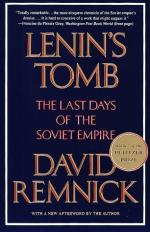|
This section contains 576 words (approx. 2 pages at 400 words per page) |

|
Moscow
The capital of the Soviet Union and Russian Federation, Moscow is the largest city in the Soviet Union and the center of trade, commerce and politics.
Russia
Prior to the Bolshevik revolution, Imperial Russia was ruled by a czarist monarchy. After the Revolution, Russia became the dominant region of the Union of Soviet Socialist Republics (USSR). In 1991, when the Union dissolved, Russia became an independent country.
Soviet Union
Following the Bolshevik Revolution and the Russian Civil War, the Soviet Union (Union of Soviet Socialist Republics) was formed in 1920.
Communism
Communism is based on a principle of socialism, whereby the citizens of a society share ownership of the means of production.
Stalinism
Stalinism describes the form of Communism enforced by Joseph Stalin during the 1940s and 1950s. Stalinism is based on Stalin's interpretation of the ideas and theories of others such as Karl Marx, Joseph Engel, Vladimir Lenin...
|
This section contains 576 words (approx. 2 pages at 400 words per page) |

|




